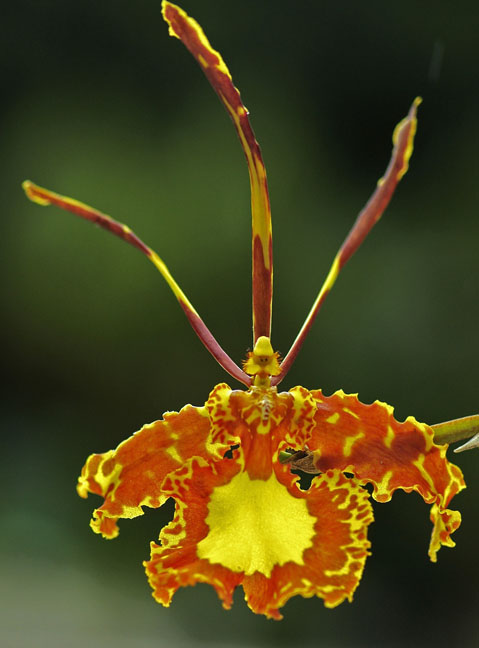Deceit is the name of the pollination game

Tom Mirenda is the orchid collection specialist at the Smithsonian Institution in Washington, D.C. He was a speaker for the annual orchid symposium put on by the Coalition for Orchid Species last Sunday in the Garden House. He brought humor and fun to his talk about orchid pollination that capped a day of terrific presentations to the 70 or so people who attended.
Orchids are sly creatures when it comes to attracting pollinators, and they employ all kinds of tricks, from mimicking other plants to faking rewards for butterflies.
 |
| Is this a swarm of rival bees or a big specimen of Oncidium sphacelatum? |
One of the orchids widely grown in South Florida is Oncidium sphacelatum, which can become a huge plant with hundreds of small yellow flowers.
From a distance, Mirenda said, this mass of flowers appears to a macho bee to be a swarm of rival bees. So, the tricked bee hurls itself at the swarm, trying to drive them away. The outcome? Pollination.
Overall, oncidium flowers mimic flowers in the malpighia family (Malpighiaceae). One of our natives, Byrsonima lucida, is the larval host plant for Horace’s Duskywing, a small brown butterfly. It is called locust berry and has “clawed” petals and oil-filled glands below them. Female bees collecting oil to feed their brood visit these flowers. A different kind of bee visits the stigmas to collect pollen. In other words, the flower rewards the bees for visiting, and is pollinated at the same time. Many of the species in the family have flowers with oil rewards.
The shape of the sepals and petals of oncidiums resembles malpighia flowers so well that bees are fooled into visiting them, hunting for oil. They don’t find any, but they get the pollination job done.
Orchids, Mirenda said, take advantage of insect behavior and develop strategies to fit that behavior. Many flowering plants offer rewards for pollinators, including nectar, pollen, floral fragrance, resins and oils. Many orchids have evolved to imitate some of these without going to the trouble of producing nectar, fragrance resins or oils.
Epidendrums look a little like milkweeds, which lure their butterfly pollinators with copious amounts of nectar. Butterflies will search these orchid flowers, looking for their reward, only to be deceived. But the orchid benefits by being pollinated.
Mirenda pointed out that one of our native orchids, Calapogon tuberosa, has a flower with the lip pointing up. Just near the top of the lip are little yellow structures resembling short, wiry hairs. “Bees climb the column to get what appears to be pollen, the lip folds over, and the flower is pollinated.”
 |
| Psychopsis papilio: what pollinates it? No one knows. |
There are any number of deceitful practices orchids have evolved. Bulbophyllums and slipper orchids imitate a brood site for flies. Coryanthes orchids trap insects by dripping what appears to be nectar into a structure shaped like a bucket. The only escape is a narrow passage that requires the insect to squeeze by the pollen site and carry pollinia to the next flower.
Bee orchids, in the genus Ophrys, imitate female bees so convincingly that male bees try to mate with them. Lepanthes glicenstenii is an orchid with a structure that imitates female fungus gnats.
For all the weird and wonderful things known about orchid pollination, there still are mysteries to solve, he said. Termites might pollinate the underground orchid in Australia, Rhizanthella gardneri. No one knows for sure. Nor has anyone ever seen what pollinates Psychopsis papilio , the big yellow and brown orchid that looks like a butterfly.
Gongora tricolor produces a sex pheromone that attracts bees. How on earth did it evolve to do that?
Stay tuned. Orchid research is going on constantly.
